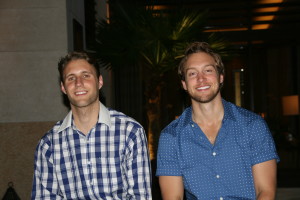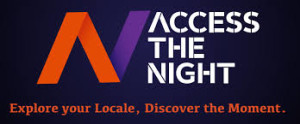
Andrew Tuffin and Sam Kessler, co-founders of Access the Night.
Last week,
Access the Night, a new social discovery app for travelling which the founders call “Yelp with pictures,” launched in Austin. Andrew Tuffin, co-founder, answered the following questions, by email, about the new startup and its product, which they have been developing for the past two years.
Q. What is Access the Night?
Access The Night is a social discovery app for travel and entertainment. We provide a different approach to the local entertainment search problem, by showing you real time Instagram photos from nearby places of interest. Anything from whats going on right now at a bar, unique neighborhood food options, outdoor attractions, and concert venues, we show you those experiences first hand.
Q. How did you come up with the idea?
We conceptualized the idea 3 years ago as seniors in college. The idea stemmed from the age old question of “What’s going on right now”? At the time there wasn’t a central location to find information on what to do based on where you were. You would have to search multiple sources across the internet to find this information, and it was often outdated. We built a basic framework in 2011, that organized local happy hours and specials in Boulder, Colorado and Lawrence, Kansas. It was at this point that we realized if we were going to pursue our dream of starting ATN, scalability would have to be our primary goal. So, we built a platform that let bars and restaurants push deals to a front-end app. We tested this concept out and soon recognized a disconnect between mobile deals and the consumer. The consumer did not particularly want mobile deals, however they appreciated mobile deals if they were in relation to something that had already piqued consumer interest. To conquer this hurdle, we turned to the technologies of Instagram which had a plethora of photos, which we could cross reference with the user’s location. This move aligned us perfectly with the marketing connection we aim to facilitate.
Q. Who are your customers?
Our core customer profile includes music venues, bars and restaurants. We also have seen a lot of interest from local boutique shops, hotels, museums, and many outdoor amusement parks and exhibits.
Q. Who is on your team?
The original founders Sam Kessler and Andrew Tuffin have been on the project since it’s inception in 2011. I attended high school with Kessler in Dallas, and would of never dreamed at the time we would eventually start a company years later. Kessler ended up attending the University of Colorado at Boulder, and I studied at Kansas. We regrouped in Dallas to start the original Access The Night, launching in early 2012.
Q. Why are you guys the ones to do this startup?
 We both share the same vision for Access The Night, but bring two different perspectives that provide the appropriate balance to growing this company. We are never hesitant to question in depth a decision or move, and keep each other accountable. While, we are more in-tune with the business operations side, we have accumulated a vast knowledge of the technical side as well. Experience is key and after almost three years, we know the space well, what the market wants, and ultimately how to get through the ups and downs that starting a company can bring.
We both share the same vision for Access The Night, but bring two different perspectives that provide the appropriate balance to growing this company. We are never hesitant to question in depth a decision or move, and keep each other accountable. While, we are more in-tune with the business operations side, we have accumulated a vast knowledge of the technical side as well. Experience is key and after almost three years, we know the space well, what the market wants, and ultimately how to get through the ups and downs that starting a company can bring.
Q. What challenges do you face bringing your startup into the marketplace?
We had a classic chicken and egg dilemma when we first launched. We needed a massive amount of content on the app side to spark user interest, and bars and restaurants needed the users to find value in using our product. We solved the initial challenge of generating content by transitioning to photos non reliant on client input. Today we face the challenge of breaking through limited user beliefs that our app is still a primary deals/happy hour app. Our goal is to raise awareness to the fact that ATN can be used worldwide, in many unique ways, day and night.
Q. How do your acquire customers?
We acquire customers through identifying major issues they have with their current marketing efforts, and finding a solution to address their needs. We work hand in hand with these businesses to help them achieve their goals and are providing them with cutting edge technology in doing so. We are experts in this industry and strive to prove ourselves by putting customer service above anything else.
Q. What is the business Model?
Our business model is selling monthly subscriptions to venues. Once a member, a venue can connect and promote directly over their respective photos already present on the Access The Night app. Our clients can advertise how they see fit, with no limit on the number of posts they make. Our backend merchant platform offers extensive information on consumer habits, and beneficial marketing insight relevant to their location. We currently negotiate contracts based on the number of users and engagement in their area.
Q. Are you bootstrapped or do you have angel or VC financing?
Our project is entirely bootstrapped up to the point. We have strategically allocated our resources to focus on innovation first and foremost in attempt to deliver a product that the market would be most receptive towards.
Q. What Austin resources have you found most helpful?
Austin’s startup community as a whole has been the most valuable and helpful resource. I frequently attend events, and networking meetups to stay connected. This gives me a better idea of the direction that early stage companies and entrepreneurs are taking, which opens up more opportunities to work together. Since moving to Austin, I have appreciated the collaborative work environment and mentorship from some very influential people in the tech industry.
Q. What has been your biggest win so far?
Our biggest win would be navigating through the challenges of a major pivot. At the beginning of 2013, we shifted from a primary deals app to a social discovery tool. We were completely out of commission, and did not have a product for almost 9 months, as we started again from scratch. When we re-launched last August, the feedback was extremely positive and the vision became clear as to what direction we would take.
Q. What is your long-term vision?
We continually strive to evolve and stay ahead of the curve by implementing features that set trends in innovation. Our team is focused on making ATN a more socially intuitive platform and social network with the ability to predict a user’s needs and wants. Simplicity and ease of use will remain vital components of the ultimate experience of using the app as we grow.
